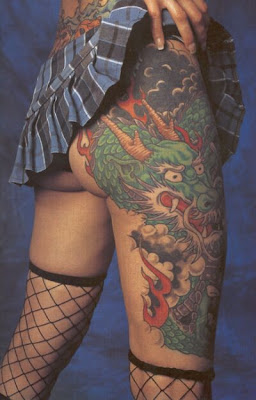Dragon tattoos come in many different shapes, styles and sizes, but they all have certain things in common. The dragon tattoo, popular with both men and women, sends a solid message without the need to be formidable (although it certainly can be). Many dragon tattoos are designed to be spiritual, and to send a message of intelligence and compassion.
The word dragon comes from 2 Greek words:
- Drakon: meaning a very big serpent.
- Drakein: meaning I see clearly.
The dragon is a mythological creature that is both fearsome and beautiful, and is the subject of folklore around the world. It is a formidable creature, usually seen as a winged or scaly beast with enormous claws that can emit fire from its mouth. In the Western world, dragons are often seen as mean or scary, but Asian dragons carry a different message.
Dragon tattoos and dragon art in general don't all convey the same meaning. Dragons are part of the myths of many different cultures and in each culture it has its unique set of characteristics and meanings.
Chinese and Japanese dragon tattoos are very popular, but there are many other designs of dragon tattoos, all of which appeal to a wide variety of people. Today's tattoo artists create dragon tattoo art that can look traditional or modern, tribal or realistic, sweet (baby dragon), charming or terrifying. Some dragon tattoo designs are relatively small, while others are full sleeve or large enough to wrap around the trunk of the body. The dragon tattoo is a strong image and sends a strong message.Japanese Dragon Tattoos:The dragon is an important part of Japanese mythology. In Japan, the dragon is seen as a water deity (that's why Japanese dragon tattoos often include clouds).
Japanese dragons have the following characteristics:- No wings
- Serpentine-like
- The head of a camel
- Scales of a carp
- The paws of tiger
- Claws like an eagle
- Japanese dragons often have long whiskers
- Sometimes they have a jewel under the chin.
Other interesting aspects of the Japanese dragon includes the fact that many in Japan believe that the first emperor of Japan was somehow descended from a dragon, giving it a position of high respect in Japanese culture. Dragons are often used in Japanese art to represent protection of the imperial family.
The Japanese dragon tattoo represents:
- Power
- Family
- Protection of family and home
- Longevity
No wonder the dragon tattoo is a popular Yakuza (Japanese Mafia) design. There are many types of Japanese dragons, including:
- Sui-Riu the king dragon who controls the rain.
- Han-Riu the biggest dragon, has stripes on his body
- Ka-Riu a smaller red dragon
- Fuku-Riu the dragon of luck
Japanese dragon tattoos are often combined with other design elements like koi fish, cherry blossom, clouds, Japanese characters, a tiger, flames, a pearl, water, the yin yang symbol, a fairy. The design in this picture is an interesting combination of black and white dragon head with a koi body.
Chinese Dragon Tattoos:
The dragon has long represented mystery and power in China. Although dragons often have been represented in a negative way, Asian dragon tattoos and particularly Chinese dragon tattoos represent:
- Intelligence
- Good luck
- Strength
- Health
- Harmony
- Benevolence
Dragons have a Yang (male) nature and are associated with the number 9, a lucky number in China because it is the biggest possible single number.
- A horned dragon tattoo the wearer choose to be mighty in their actions or words.
- The earth dragon rules the earth and sends a message of connection to the earth or land.
- The yellow dragon a hornless dragon known for scholarly knowledge.
- The celestial dragon protects the Gods. Many people with strong spiritual beliefs choose the celestial dragon to share those beliefs and confirm their own spiritual path. It's one of the most popular tattoo dragons.
European Dragon Tattoos:
Dragons are an important part of the world of mythology, folklore and fairy tales in (medieval) Europe. European dragons are quite different from Asian dragons, though they are recognizably the same creature.
The fairy tale dragon may be on its own or the dragon tattoo may be accompanied by other associated images think knights or fairies for example. The lines are likely to be finer, with intricate detailing. These dragon tattoos make a beautiful and striking visual image.
The appearance of European dragons:
- Wings growing on its back (that look like the wings of a bat). Most oriental dragons don't have wings.
- Usually has a long tail.
- 2 or 4 legs
- Lives in a cave or underground lair. The European dragon is linked to the element earth
- Most European dragons are malevolent
Dragons also take their place in Celtic mythology. The red dragon in particular is associated with the Britons (the Welsh) and the white dragon with the Saxons. The red dragon is one of the few European benevolent dragons.
In ancient Roman times, the dragon was a mix of Greek dragons and Asian dragons, creating an interesting blend of Western and Eastern influences.




















0 comments:
Post a Comment